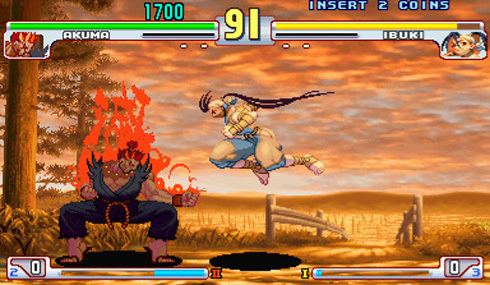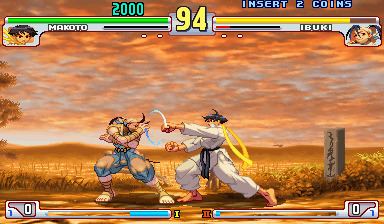9.2 /10 1 Votes
Composer(s) Hideki Okugawa Series Street Fighter | 4.6/5 Emuparadise Cabinet Upright Initial release date 12 May 1999 | |||||||||||||||||||||||||||||||||
 | ||||||||||||||||||||||||||||||||||
Producer(s) Yoshiki OkamotoNoritaka FunamizuKouji Nakajima Designer(s) Toshiba IshizawaHaruo MurataTomonori Ohnuma Mode(s) Up to 2 players simultaneously Similar Street Fighter games, Capcom games, Fighting games | ||||||||||||||||||||||||||||||||||
tas street fighter iii 3rd strike arc ryu 4k
Street Fighter III 3rd Strike: Fight for the Future (ストリートファイターⅢ サードストライク FIGHT FOR THE FUTURE) is a 2D fighting game developed and published by Capcom, originally released for the arcades in 1999. It was ported to the Dreamcast, PlayStation 2, and Xbox between 2000 and 2010. A downloadable online version titled Street Fighter III: 3rd Strike Online Edition was released on PlayStation Network and Xbox Live Arcade in 2011.
Contents
- tas street fighter iii 3rd strike arc ryu 4k
- Street fighter iii 3rd strike fight for the future arcade longplay ryu hard difficulty
- Gameplay
- Characters
- Release
- Online Edition
- Soundtrack
- Reception
- References

Street Fighter III 3rd Strike is the second follow-up to Street Fighter III, following Street Fighter III: 2nd Impact. Like its predecessors, it runs on the CP System III hardware. 3rd Strike increased the character roster by adding five new characters, notably including Chun-Li. It also added further refinements to the previous game's play mechanics and rules. The game was well received in all of its versions.

Street fighter iii 3rd strike fight for the future arcade longplay ryu hard difficulty
Gameplay

Released in May 1999, the third and final installment of Street Fighter III brought back the classic Street Fighter II character Chun-Li, along with four new characters (Makoto, Remy, Q, and Twelve), extending the selectable roster to 20 characters, with Akuma now being a regular character. All of the returning characters from the previous Street Fighter III games were given new stages, endings, and voice actors for certain characters, continuing the overall storyline from where the first two games left off.

The commands for air parries, throws/holds, and leap attacks were changed from 2nd Impact. Additionally, the player can perform a "Guard Parry" or a parry during a guard stun if the timing is right. A "Guard Parry" is also known as a "Red Parry" because the character turns red when performing it. The game also introduces a grade-based "Judgement System", in which the winning player in a single or two-player match is graded after the match based on offense, defense, techniques, and extra points. Special points are also awarded after fulfilling specific requirements.

The single-player mode consists of fighting ten regular opponents, which includes a character-specific rival as the penultimate opponent and Gill as the final boss for each of the characters except for Gill himself, whose final boss is Alex. Despite his status as a regularly selectable character, the CPU version of Q can only be fought in the single-player mode as a secret challenger. The "Parry the Ball" minigame from Street Fighter III: 2nd Impact returns as well as a new version of the "Crush the Car" minigame from Street Fighter II.
Characters
All the characters from 2nd Impact returned, with the exception of Shin Akuma, a computer-controlled version of Akuma with more powerful techniques (although the character still exists in the game's code). All of the returning characters, with a few exceptions, had new voice actors for 3rd Strike. The following five characters were added to the roster:
Release
Street Fighter III: 3rd Strike was originally released for the arcades in 1999. There are three revisions of the arcade board, with differences in bugs and gameplay mechanics (specifically, "unblockables" for the character Urien).
The Dreamcast version was released in 2000. Like Double Impact, this port features an Arcade, Versus, Training (with normal and parry training) and Options modes, as well as a "System Direction" mode which allows the player to adjust several of the game's features. Like in Double Impact, Gill can be selected by the player, but only after fulfilling certain requirements. Also, one additional remix of each character's musical theme, not present in the original arcade version, was composed for this version, and it was played during the third round of each match. These additional remixes were also included in the PlayStation 2 version.
A PlayStation 2 version of 3rd Strike was released in 2004, with all of the features from the Dreamcast version, including a choice between the arcade and Dreamcast version's respective soundtracks. It was released in Japan as a standalone game, with a limited edition package containing an All About Street Fighter history book, a 500-piece jigsaw puzzle, and a strategy DVD. The PS2 version was released in North America as part of the Street Fighter Anniversary Collection, a two-in-one bundle that also includes Hyper Street Fighter II. The PS2 version was not released in the PAL region. The PS2 version was re-released in Japan on September 18, 2008 in a two in one bundle with Capcom vs. SNK 2.
An Xbox version of the Street Fighter Anniversary Collection was also released during the year in all three regions. The Xbox version of 3rd Strike includes all of the features from the PS2 version, as well as an online Versus mode. All original Xbox games lost online capabilities on April 15, 2010.
Online Edition
At the 2010 San Diego Comic-Con, Capcom announced that an online edition of 3rd Strike titled Street Fighter III: 3rd Strike Online Edition was in development. The game features enhanced visual settings, GGPO-built online play and was ported by Iron Galaxy Studios. The port has similar features to Final Fight: Double Impact, including visual filters, an optional remixed soundtrack by Simon Viklund, and bonus content unlocked by completing in-game achievements. Other new modes include Tournament and Spectator modes, as well as Trial modes that teach the game's fundamentals and the ability to share replays on YouTube.
Online Edition was released for PlayStation Network on August 23, 2011 and on Xbox Live Arcade on August 24, 2011. Although marketed as "arcade perfect", its codebase is derived from the PS2 port . The game reached #8 at the PSN download sales chart. A final patch to correct certain issues with the game was released on February 12, 2014.
Soundtrack
The themes for the games are predominantly house and drum and bass, with some jazz, hip-hop, and techno elements. While Yuki Iwai worked on the soundtracks for New Generation and 2nd Impact, Hideki Okugawa worked on all three games. The soundtrack to the first game in the series was released on CD by First Smile Entertainment in 1997, while the 3rd Strike original soundtrack was released by Mars Colony Music in 2000 with an arranged version afterwards. The soundtrack to 3rd Strike features three songs and announcer tracks by Canadian rapper Infinite.
Reception
Street Fighter III: 3rd Strike was initially met with mixed opinions, however it has in recent years been critically acclaimed. In 2004, Game Revolution said that it "just isn't a very exciting addition. The game is essentially like all the other Street Fighters, but with a parrying system", before concluding that it does not do "anything remotely interesting graphically; unsurprising when you consider that these games have barely grown at all visually in fifteen years" IGN said it was "worthy of just about anyone's private collection... that is unless you already have Double Impact," while CNET said it was "weaker in the graphics department than its predecessor."
Retrospectively, Third Strike was ranked as the 11th best arcade game of the 1990s by Complex; the magazine also placed it tenth on their list of best 2D fighting games of all time in 2013, stating it "is a lot better than many people ever gave it credit for." It was named as the best retro Street Fighter game by Alex Langley of Arcade Sushi that same year.
